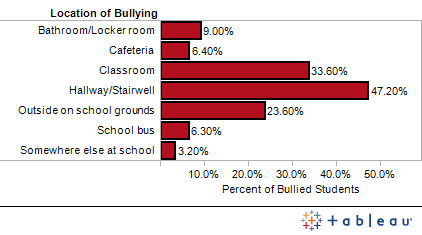By Tony Briscoe
Staff writer
Bullying has become an increasingly popular topic to a major research group that indicates 28 percent of all students between 12 to 18 years old are victims of maltreatment.
School hallways and stairwells are the most common places. According to the U.S. Department of Education’s National Center for Education Statistics, more than 47 percent of students who’ve reported they’ve been bullied said that it has occurred in those locations.
Another nine percent of targeted students said they were bullied in the bathroom or locker room while another six percent were harassed on the school bus.
This comes as no surprise to high school teacher Carman Smith. An English teacher at Wylie E. Groves High School in Beverly Hills, Mich., Smith said he has to intervene in bullying altercations at least once a day.
“A lot of times it happens in between classes in the hallways, it happens in the locker rooms, it happens in common areas, before school, after school, on the bus, at the bus stop … I would say most happen outside of the classroom.”
While many students reported being bullied in transition, 33 percent of victims identified the classroom as a bullying focal point.
Kevin Epling, co-director of anti-bullying advocacy group Bully Police USA, said that this could be from the inaccurate, stereotypical view that most people have of bullies.
“One of the old adages was that bullies have low self-esteem. What we’re finding more and more is that bullies have a very high self-esteem and a lot of the bullies tend to be the teacher’s pet. They’ll do everything the teacher says, so they’re not noticed as the bully, but they’ll turn around and do something to you behind their back.”
Smith said that Groves teachers are more than capable of handling bullying in the classroom. The school, with roughly 1,400 students, has anti-bullying policies as well as prevention programs such as peer mediation.
“It is a part of our house rules that we report any type of hazing or bullying or someone being treated unfairly,” said Smith. “Each individual case is handled separately, so the actual consequences depend on the situation.”
The district also has had seminars where teachers undergo training on how to resolve bullying situations.
One of the biggest problems the group is struggling to manage now is cyberbullying. According to a 2011 Pew Internet report, eight percent of students have been bullied online in the past 12 months. Smith, who’s been teaching since 2002, said bullying has become an unmanageable problem because online issues now spill into the classroom.
“I think bullying has always been there, but it’s gotten worse because of cyberbullying,” said Smith. “It’s brought on a whole new phenomenon. The access these kids have to the Web, and what they can do with the Web, it’s brought bullying to a whole new level.”
Since bullying has gone beyond the schools, Smith says it’s up to parents to monitor their children’s online activity. He encourages parent to create their own social media site to supervise.
“I think more parental control of these social media sites could help the problem. I have no business going on a student’s Facebook or Twitter page. There’s only so much I can do in the (school) hours.”

Leave a comment